Incentives Work : Local businesses are constantly looking for effective ways to attract and retain customers. Traditional local business advertising methods can be costly and often yield limited results.

One strategy that has gained popularity is offering customer incentives. By providing rewards and benefits, local businesses can create a loyal customer base and drive sales.
But what makes incentives so effective? The answer lies in their ability to create a personal connection with customers, making them feel valued and appreciated.
Table of Contents
Are ads losing efficiency for small businesses?
Yes, ads are generally losing efficiency for small businesses. Rising costs, increased competition, and stricter privacy regulations have made traditional digital advertising less effective. Smaller businesses often lack the budgets and data needed to optimize campaigns on platforms like Google or Facebook, resulting in lower returns. Additionally, consumers are experiencing ad fatigue, which reduces engagement with repetitive or irrelevant ads. As a result, many small businesses are turning to alternative strategies—such as customer incentives, email marketing, and local engagement campaigns—to achieve better results and a higher return on investment.
Why do customers respond more to instant rewards?
Customers respond more to instant rewards because human behavior is strongly influenced by immediate gratification. When a reward is offered right away, it triggers the brain’s pleasure and reward centers, creating a sense of satisfaction and positive reinforcement. This immediate feedback makes the customer feel valued and recognized, increasing their likelihood of repeating the desired behavior, such as making a purchase or engaging with a business. In contrast, delayed rewards often lose their impact because people tend to discount future benefits in favor of immediate outcomes. Instant rewards also build stronger emotional connections between the customer and the brand, fostering loyalty and encouraging ongoing engagement. Essentially, the faster the reward, the stronger the psychological incentive to act.
Are your traditional advertising methods failing to bring the results your local business deserves?
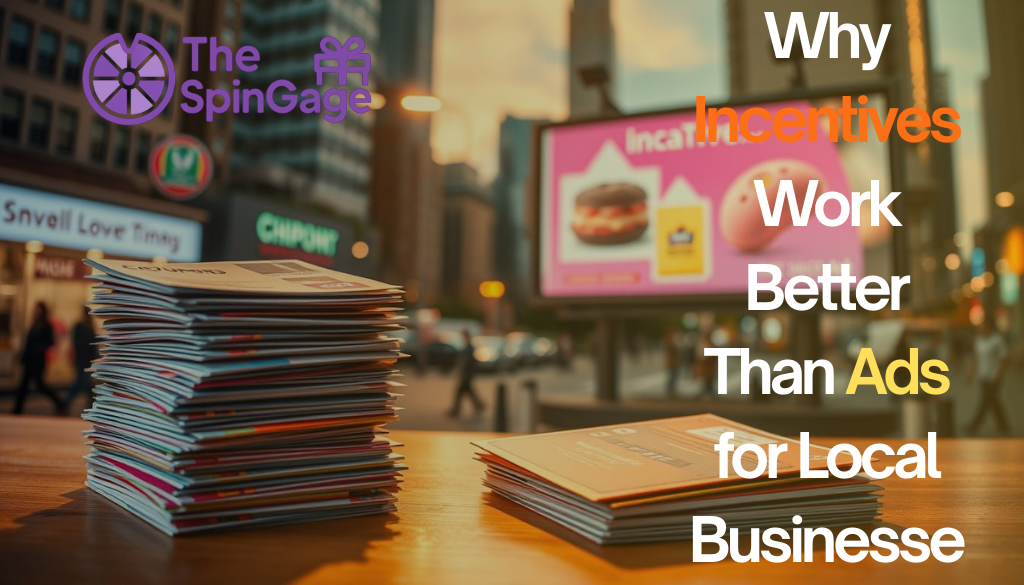
In today’s competitive marketplace, rising advertising costs and growing consumer skepticism have made traditional methods like print ads, billboards, and social media campaigns less effective than ever. That’s why more local businesses are turning to customer incentives—a strategy proven to build loyalty, drive sales, and foster genuine connections with clients. By offering tangible rewards such as loyalty programs, referral bonuses, or limited-time offers, you provide your customers with real value that resonates on a personal level, encouraging repeat visits and positive word-of-mouth. Unlike traditional ads that get lost in the noise, incentives create a direct exchange of value, measurable results, and actionable insights through digital tracking tools, allowing you to optimize your efforts for maximum ROI.
How does SpinGage replace ads with gamified engagement?
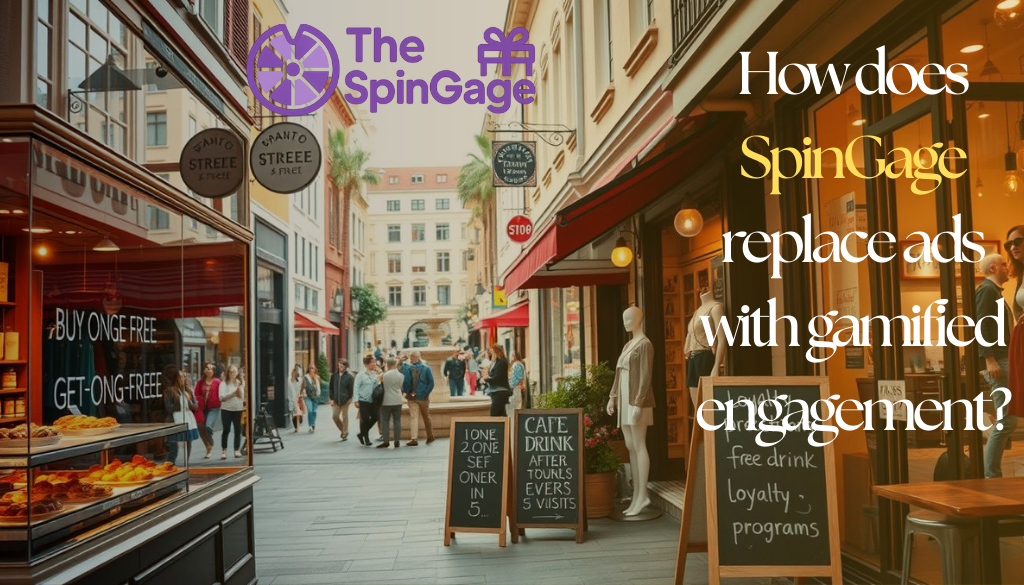
SpinGage replaces traditional advertising by shifting the focus from passive promotion to interactive, gamified engagement. Instead of bombarding users with banners or pop-ups, SpinGage motivates customers to participate in fun, reward-based activities, such as spinning a virtual wheel, completing challenges, or earning points. This approach transforms marketing into an experience where users are actively involved, creating emotional connections with the brand. By offering tangible incentives—like discounts, freebies, or loyalty rewards—SpinGage encourages repeated interactions and builds long-term customer loyalty. Essentially, it turns engagement into a game, where the excitement of winning or earning rewards naturally drives attention and retention, outperforming conventional ads that users often ignore.
How does SpinGage automate review collection?
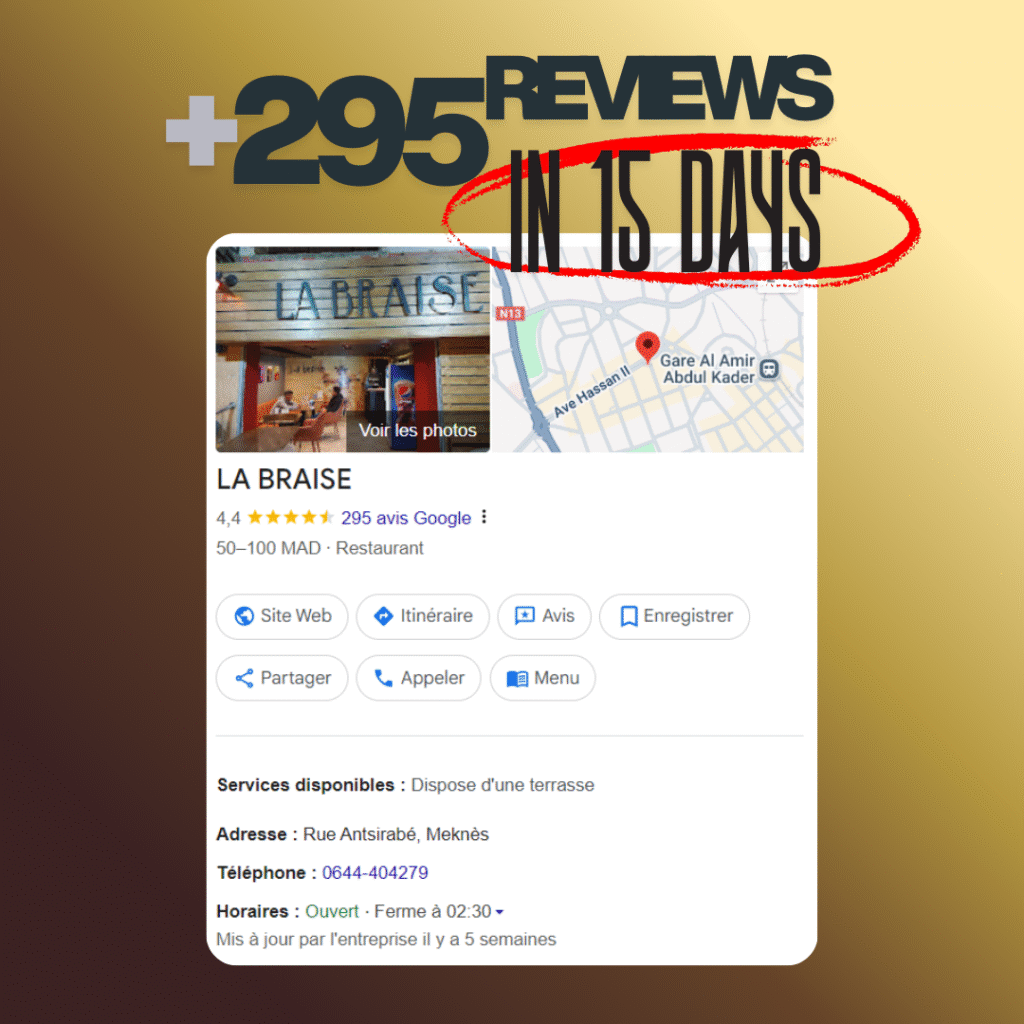
+295 REVIEWS IN JUST 15 DAYS :
Labraise is a restaurant that gained more than 295 new customer reviews and increased their income by using TheSpinGage solution.
They placed a flyer with a QR code on every table, allowing each diner to scan and spin the wheel. Labraise used a 100% winning ratio plan, where customers always won either 10% off their meal or a free soda.
This simple gamification encouraged guests to leave reviews, boosted loyalty, and kept customers coming back.
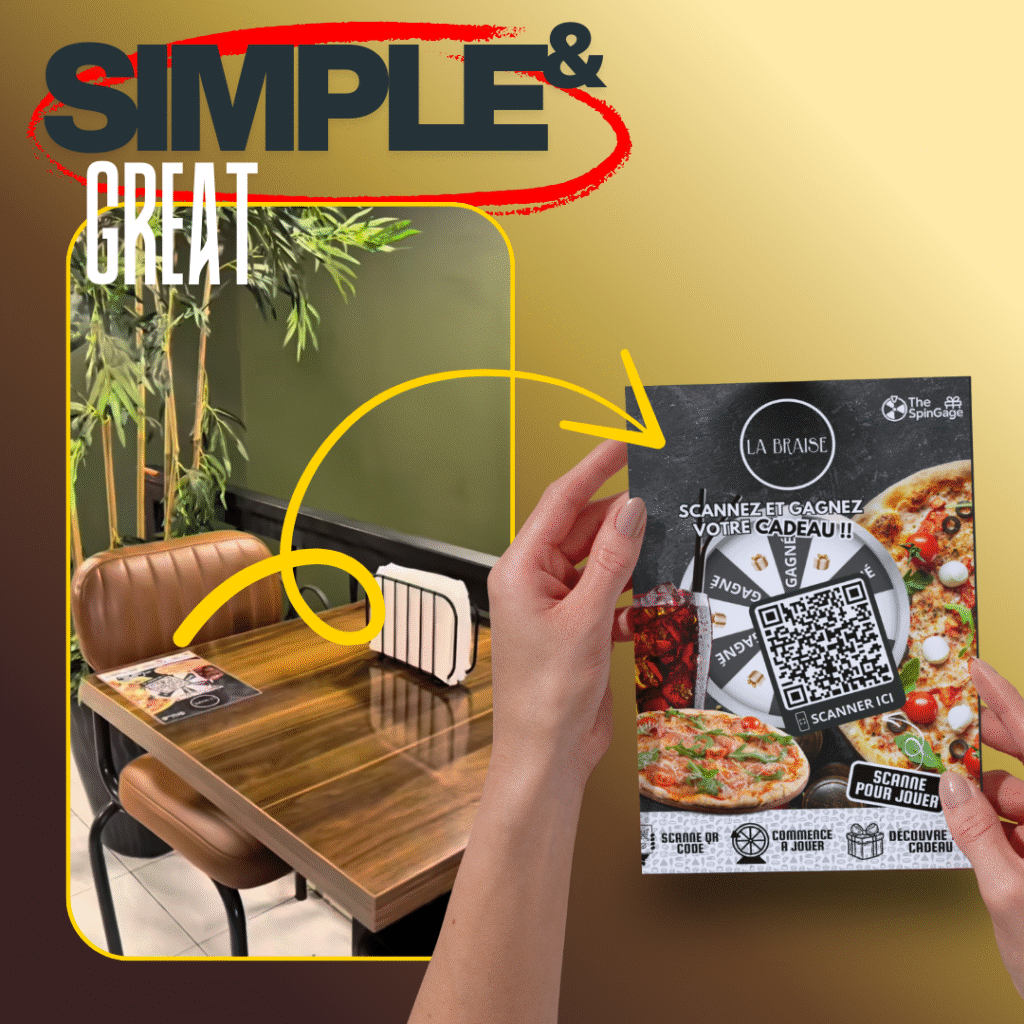
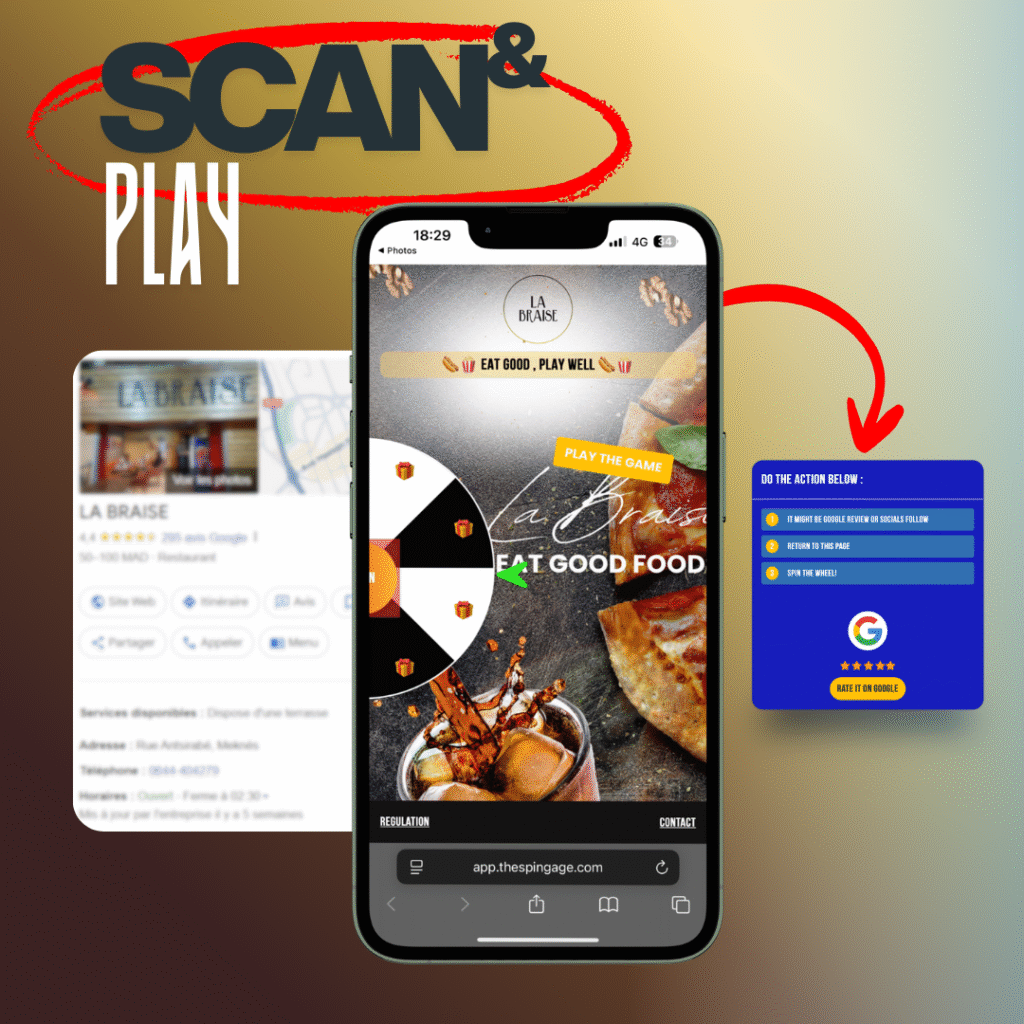
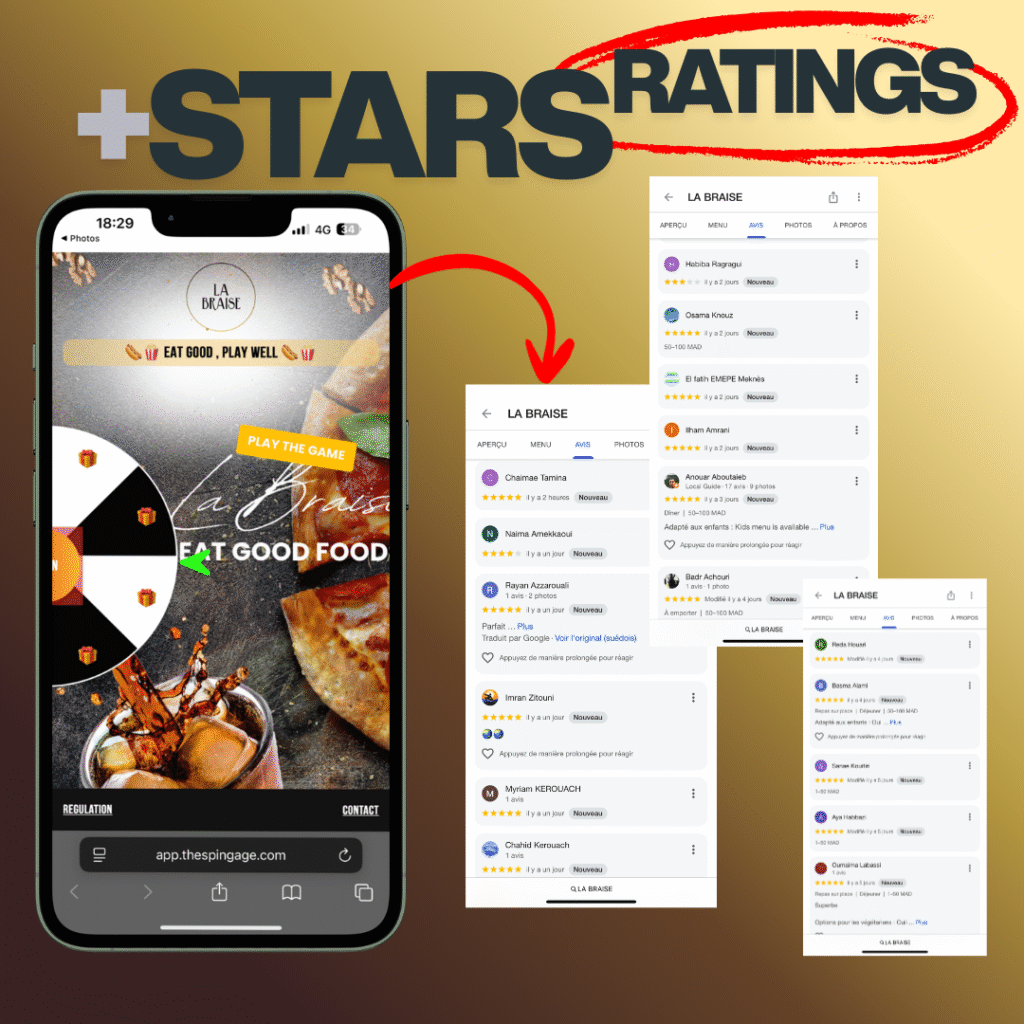
HOW IT WORKS IN 4 EASY STEPS ?
1 – Scan the QR Code
Clients simply scan the QR code placed on the table or provided directly by you.
2- Take Action First
To unlock the gameplay, they must complete the required action.
3- Spin the Wheel
Once unlocked, they spin the wheel to test their luck.
4- Win Rewards
If they win, a QR code is instantly sent to their email. If not, nothing happens. In both cases, the game is locked for 24 hours, ensuring fairness and excitement for the next try.
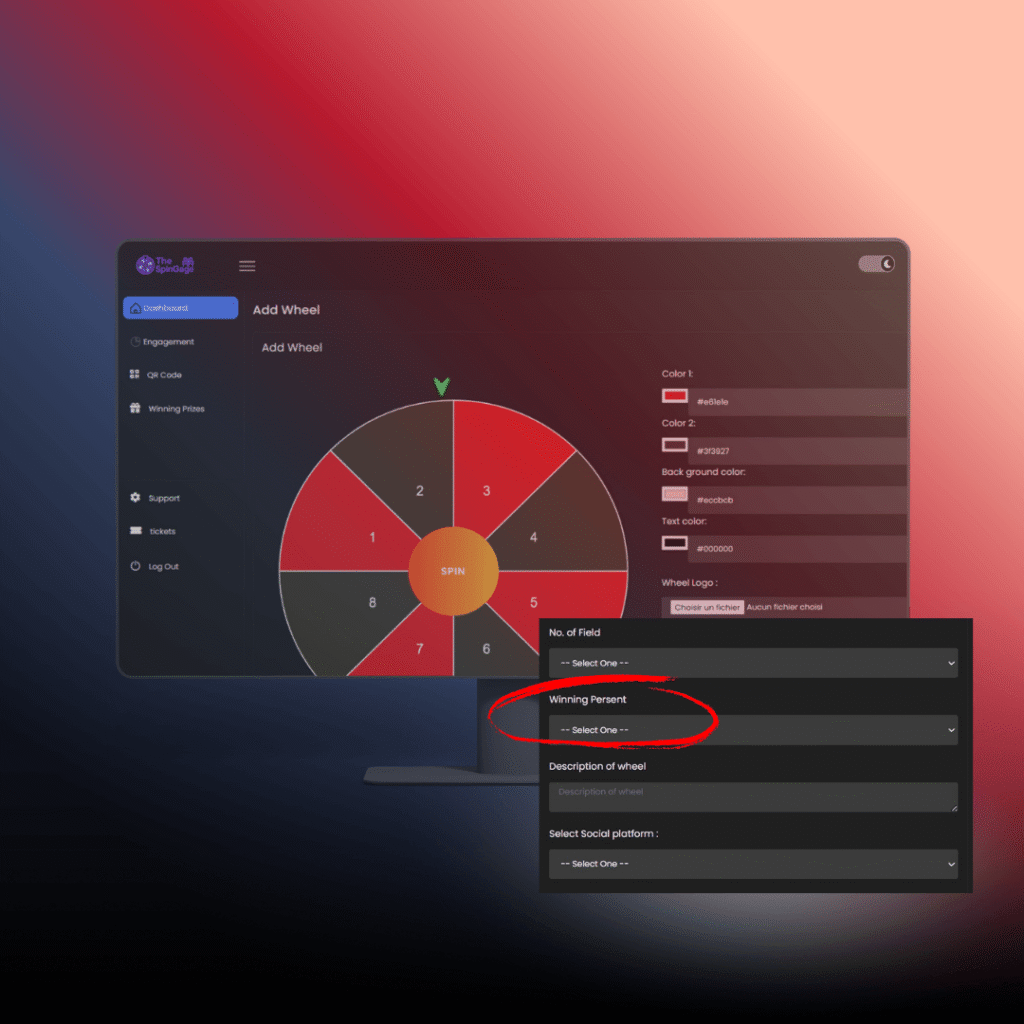
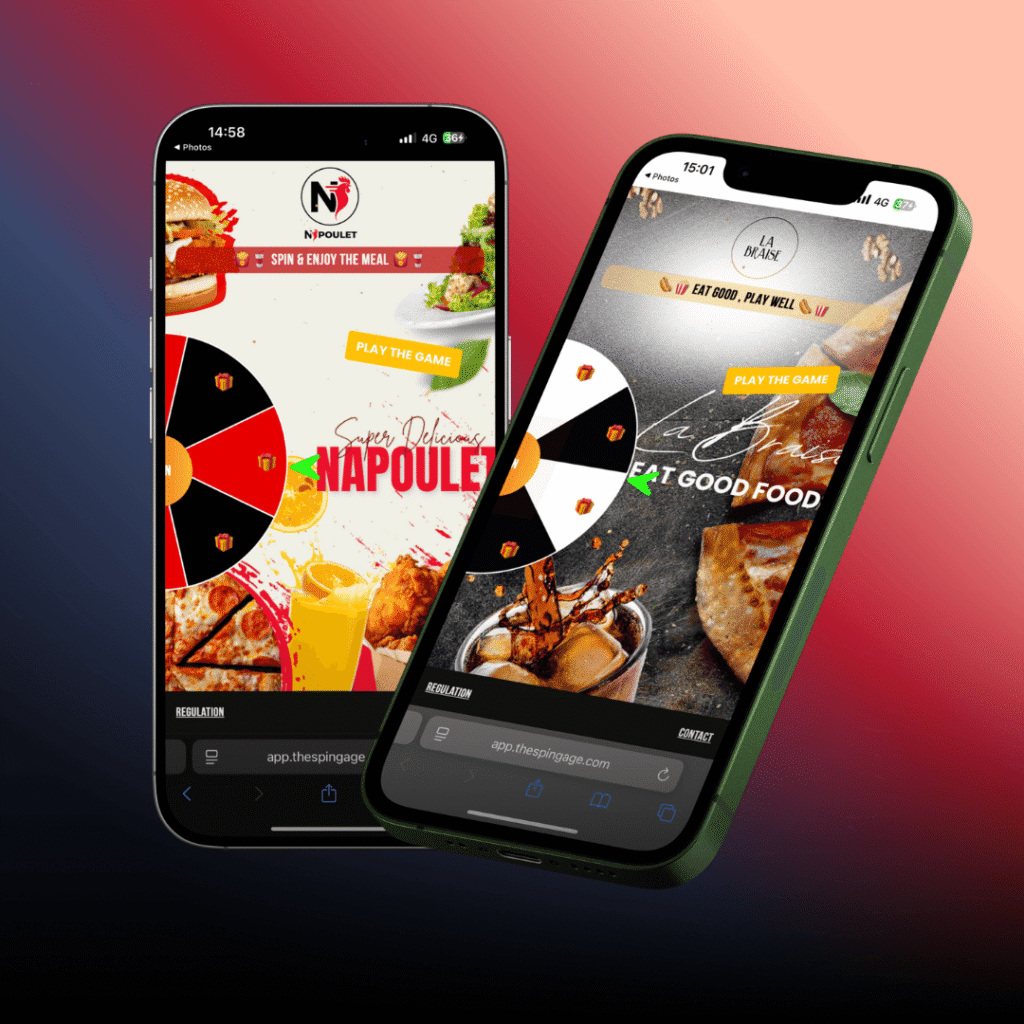
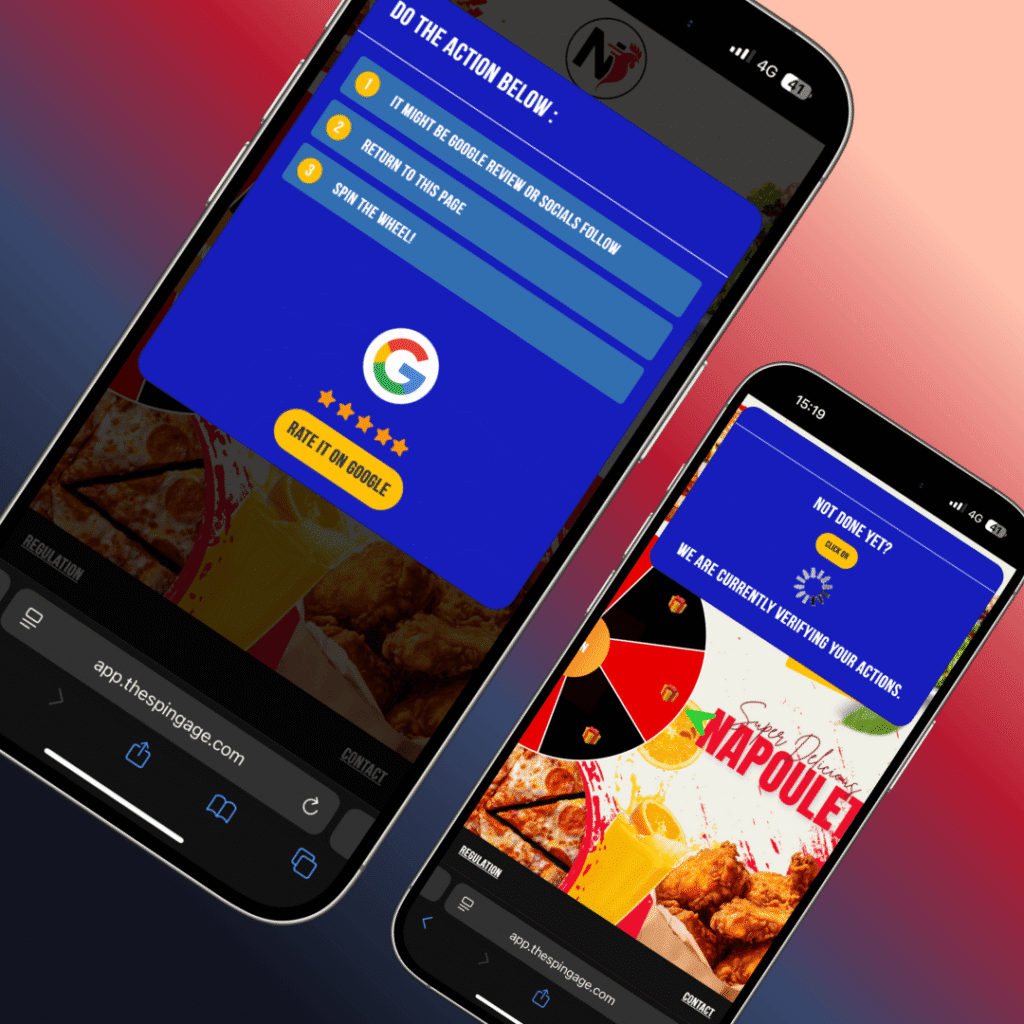
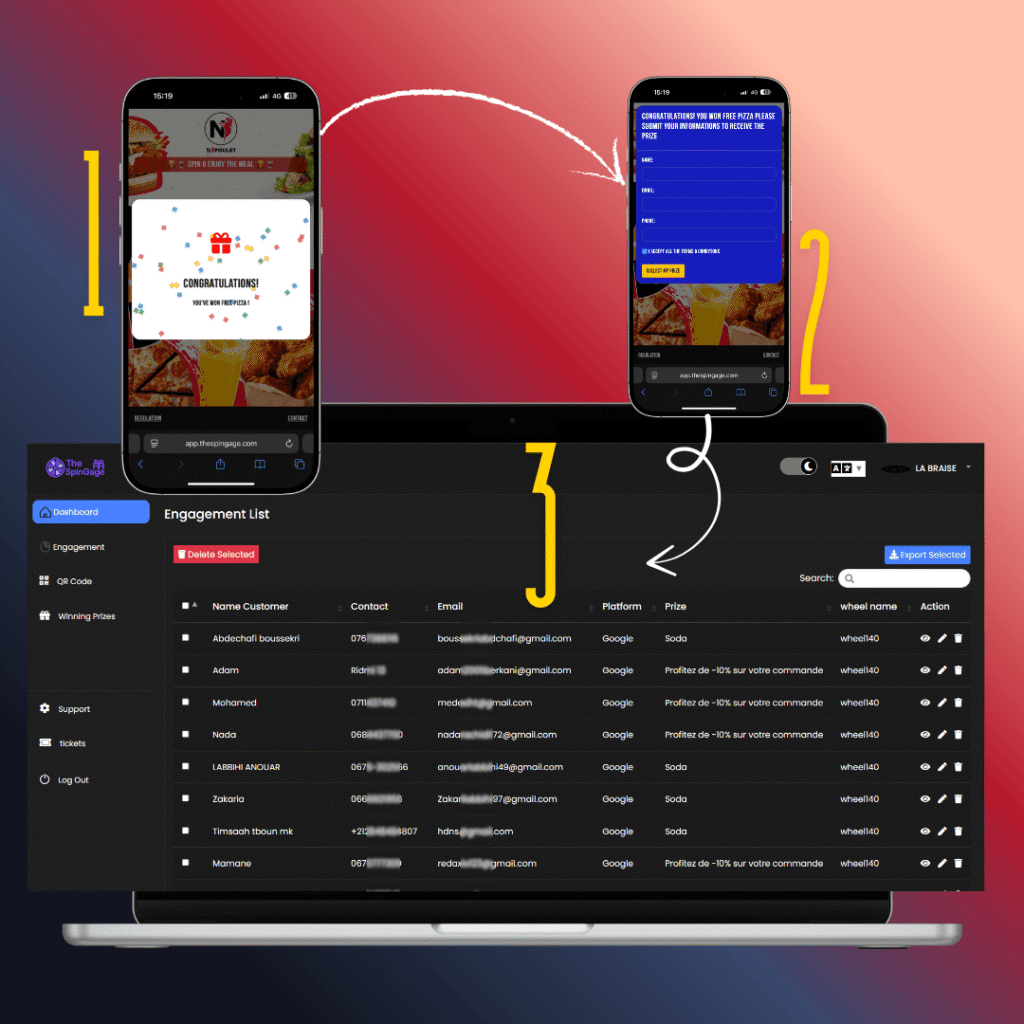
🛠️ Flexible Tracking Options
Track platform Top performing .
Track the wheel segments (number of prizes, Winner Gameplay).
Number of Plays , Track top performing wheel
Set up expiration dates for vouchers and offers.
Get Acces to LEADS , Extraxt & Modiify it .
Why You Should Opt for TheSpinGage Solution
Running a business today is not just about serving customers – it’s about creating memorable experiences that keep them coming back and spreading the word. That’s exactly what TheSpinGage delivers.
🎯 Stand Out from Your Competitors
Most restaurants, cafés, and shops rely only on discounts or word of mouth. With TheSpinGage, you turn every visit into a fun, interactive moment that clients remember and talk about.
⭐ Collect More Positive Reviews
Google reviews are the new “digital reputation.” Our system motivates clients to leave reviews in exchange for a chance to win rewards – giving you the social proof that attracts new clients effortlessly.
💌 Grow Your Customer Database
Every spin is an opportunity to collect emails and data, helping you stay connected with your clients through newsletters, promotions, and loyalty campaigns.
🔄 Boost Loyalty and Repeat Visits
Customers love rewards. By making every visit a chance to win, you encourage repeat visits, turning occasional clients into loyal fans of your business.
⚡ 100% Simple & Automated
No technical headaches. Once installed, TheSpinGage works automatically – whether through QR codes on tables, flyers, or digital screens. You just set the rules, and the system does the rest.
👉 TheSpinGage isn’t just a tool – it’s your new customer magnet.
Increase engagement, grow your reviews, and build a strong database without spending more on ads.
📲 Activate TheSpinGage today and turn visitors into loyal, returning customers!
START TODAY
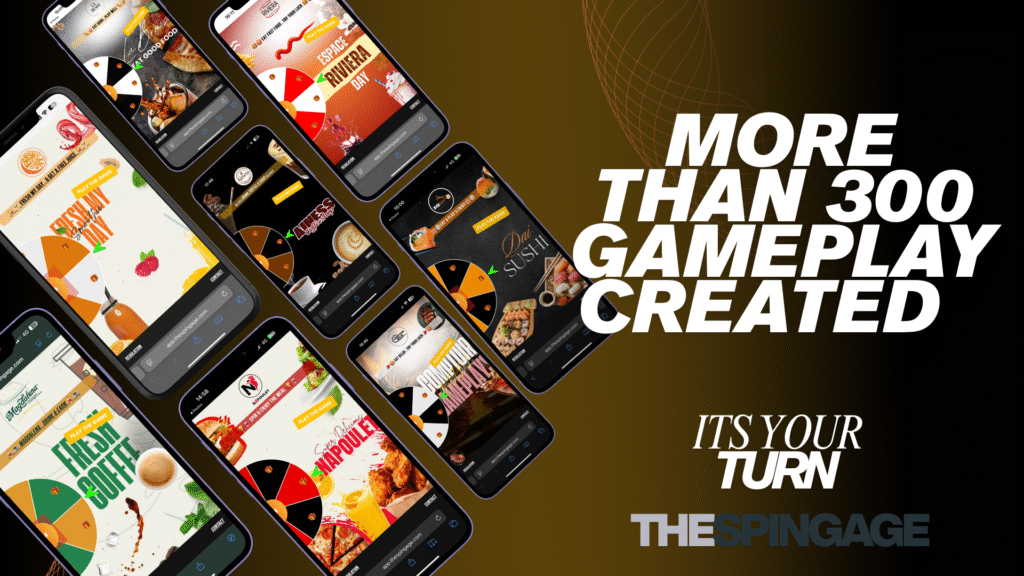
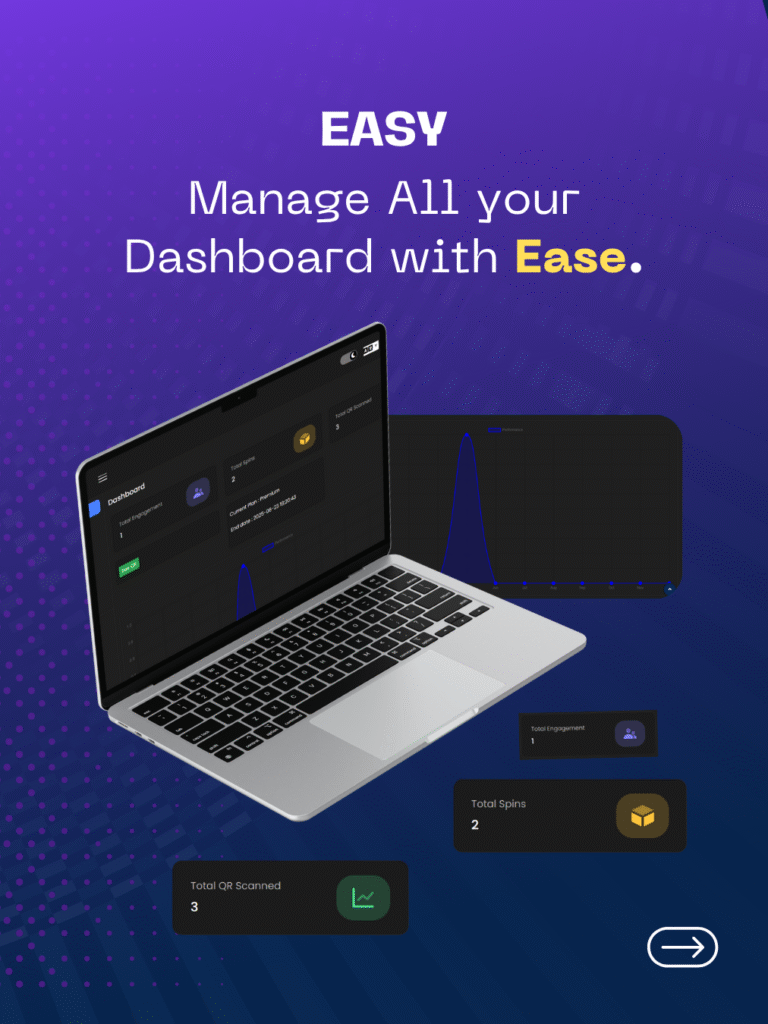
SpinGage automates review collection by seamlessly integrating with your business platforms to prompt customers for feedback at the right moment. It can automatically send personalized review requests via email or SMS after a purchase or service, making it easy for customers to share their experiences. This automation not only increases the volume of reviews but also ensures consistent and timely feedback, helping businesses maintain a strong online reputation without manual effort.
Combine this with strategic local SEO practices, including keyword research, category optimization, and building citations and backlinks, and you’re positioning your business to dominate local search
When designed thoughtfully, incentive programs not only attract new customers but also transform first-time visitors into loyal brand advocates, ultimately securing sustainable growth for your business.
Start Boosting Your Local Business with Smart Incentives →
The Current State of Local Business Advertising
Local businesses are facing a challenging landscape when it comes to advertising, with traditional methods being put to the test alongside digital alternatives. The advertising environment is complex, with various options available, each with its own set of advantages and disadvantages.
Traditional Advertising Methods Used by Local Businesses
Traditional advertising methods, such as print ads in local newspapers, flyers, and billboards, have been staples for local businesses. These methods allow businesses to reach a local audience and create brand awareness. For instance, a local restaurant might use flyers to promote a new menu item or a sale.

Rising Costs of Digital and Traditional Advertising
The costs associated with both digital and traditional advertising are on the rise. Digital advertising, including social media ads and search engine marketing, can be particularly costly due to the competitive nature of online advertising. Traditional advertising costs are also increasing, making it challenging for local businesses to maintain their advertising efforts without breaking the bank.
| Advertising Method | Average Cost | Effectiveness |
|---|---|---|
| Social Media Ads | $500-$1,000 per month | High |
| Print Ads in Local Newspapers | $200-$500 per ad | Medium |
| Billboards | $1,000-$3,000 per month | High |
As advertising costs continue to rise, local businesses must carefully consider their advertising strategies to maximize their return on investment.
The Diminishing Returns of Traditional Advertising
Local businesses are witnessing a significant drop in returns from traditional advertising. As the advertising landscape evolves, it’s becoming increasingly clear that traditional methods are no longer yielding the desired results.
Ad Fatigue and Consumer Skepticism
Consumers are bombarded with advertisements daily, leading to ad fatigue. This phenomenon results in consumers becoming desensitized to ads, making them less effective. Furthermore, the rise of consumer skepticism has led to a decrease in trust towards traditional advertising.
Low Conversion Rates for Local Business Ads
The impact of ad fatigue and consumer skepticism is reflected in the low conversion rates for local business ads. Despite significant spending on traditional advertising, many local businesses are not seeing a proportional increase in sales or customer engagement.
| Advertising Method | Average Conversion Rate |
|---|---|
| Print Advertising | 2% |
| TV Advertising | 1.5% |
| Radio Advertising | 1% |

Understanding Customer Incentives
In the competitive landscape of local business, understanding the power of customer incentives is essential. Customer incentives are designed to motivate customers to make a purchase or engage with a business, ultimately driving sales and fostering loyalty.
The Psychology Behind Incentives
The psychology behind incentives is rooted in the principle of reward, which triggers a positive response in consumers. When customers receive a reward, it activates the brain’s reward system, releasing dopamine and creating a feeling of satisfaction. As “Incentives are a powerful tool for influencing consumer behavior”, they can significantly impact purchasing decisions.
Driving Consumer Behavior
Incentives drive consumer behavior by providing a tangible reason to choose one business over another. They can take many forms, including discounts, free products, or exclusive services. By leveraging incentives effectively, local businesses can increase customer engagement, boost sales, and build a loyal customer base. As noted by a marketing expert,
“The key to successful incentives is to make them relevant, achievable, and timely.”
Why Incentives Work Better Than Traditional Advertising
Unlike traditional advertising, incentives offer a direct and personal way to engage with customers. This approach not only fosters a stronger connection between the business and its clientele but also provides a more effective way to drive sales and customer loyalty.
Direct Value Exchange with Customers
Incentives create a direct value exchange between the business and the customer. When customers receive a tangible benefit, such as a discount or a free service, they are more likely to feel valued and appreciated. This can lead to increased customer satisfaction and loyalty.
- Personalized offers make customers feel special.
- Rewards programs encourage repeat business.
- Exclusive deals create a sense of belonging.
Measurable ROI and Trackable Results
One of the significant advantages of incentives over traditional advertising is the ability to measure their effectiveness accurately. With incentives, businesses can track redemption rates, customer retention, and overall return on investment (ROI). This data allows for data-driven decision-making and program optimization.
- Track the number of customers participating in the incentive program.
- Monitor the redemption rates of offers.
- Analyze the overall impact on sales and customer retention.
Types of Effective Incentives for Local Businesses
To stay ahead of the competition, local businesses are turning to various types of incentives that encourage customer loyalty and retention. These incentives not only drive sales but also help in creating a loyal customer base.
Loyalty Programs and Punch Cards
Loyalty programs and punch cards are traditional yet effective ways to incentivize repeat business. Loyalty programs reward customers for their continued patronage, while punch cards offer a simple, tangible way to track customer purchases and reward loyalty.
- Implement a points system that rewards customers for every dollar spent.
- Use punch cards to offer a free product or service after a certain number of purchases.
Referral Bonuses and Friend Discounts
Referral bonuses and friend discounts are powerful incentives that encourage customers to bring in new business. By offering rewards for referrals, businesses can tap into the trust and networks of their existing customers.
- Provide a discount or bonus to customers who refer new clients.
- Offer a reciprocal discount to both the referrer and the new customer.
Limited-Time Offers and Flash Sales
Limited-time offers and flash sales create a sense of urgency, driving sales and increasing customer engagement. These time-sensitive promotions can be particularly effective during slow periods or holidays.
- Create flash sales with significant discounts for a short period.
- Use limited-time offers to promote new products or services.
By implementing these types of incentives, local businesses can not only attract new customers but also retain existing ones, ultimately driving business growth and success.
Case Studies: Local Businesses Succeeding with Incentives
The power of incentives is evident in the success stories of local businesses that have embraced them. By implementing well-designed incentive programs, these businesses have seen significant improvements in customer loyalty and sales.

Restaurant Success Stories
Many restaurants have successfully used incentives to attract and retain customers. For example, a local pizza place introduced a loyalty program that rewarded customers with a free pizza after a certain number of purchases. This simple incentive led to a significant increase in repeat business.
Retail Shop Transformations
Retail shops have also benefited from incentive programs. A boutique clothing store implemented a referral bonus program, offering discounts to customers who referred friends. This strategy not only drove sales but also helped to build a loyal customer base.
Service-Based Business Examples
Service-based businesses, such as salons and gyms, have seen success with limited-time offers and membership incentives. For instance, a local gym offered a discounted membership rate for new customers who signed up within a specific timeframe, resulting in a surge of new memberships.
These case studies demonstrate the versatility and effectiveness of incentives across different industries, highlighting their potential to drive business success.
How to Design an Effective Incentive Program
Creating a successful incentive program requires a deep understanding of both your business objectives and customer preferences. To design an effective program, you must align your incentives with your overall business strategy and ensure they resonate with your target audience.
Identifying Your Business Goals
The first step in designing an effective incentive program is to clearly identify your business goals. Are you looking to increase customer retention, drive new sales, or promote specific products? Establishing clear objectives will help you tailor your incentives to meet these goals. For instance, if your goal is to boost customer loyalty, you might consider implementing a rewards program that offers points or discounts for repeat purchases.
Understanding Your Customer Base
Understanding your customer base is crucial for creating incentives that appeal to them. Analyze your customers’ demographics, purchasing behavior, and preferences to design incentives that are relevant and attractive. Personalization is key; customers are more likely to respond to offers that are tailored to their needs and interests.
Creating Sustainable Incentive Structures
A sustainable incentive structure is one that benefits both your business and your customers in the long term. Avoid short-term gimmicks that might not provide lasting value. Instead, focus on creating programs that encourage ongoing engagement, such as loyalty programs or tiered rewards systems. Consider the following elements when designing your incentive structure:
- Clear rules and redemption processes
- Attractive rewards that align with customer interests
- Regular communication to keep customers engaged
By carefully designing your incentive program with these elements in mind, you can create a loyal customer base and drive long-term business success.
Implementing and Managing Incentive Programs
The success of an incentive program depends on careful planning, effective use of digital tools, and comprehensive staff training. By leveraging these elements, local businesses can create a robust incentive program that drives customer engagement and boosts sales.
Digital Tools for Incentive Management
Digital tools play a vital role in managing incentive programs efficiently. They help track customer interactions, monitor redemption rates, and analyze program effectiveness. Some popular digital tools include loyalty program software, customer relationship management (CRM) systems, and mobile apps designed for incentive management.
For instance, a local coffee shop might use a loyalty app that rewards customers with points for every purchase. The app can track customer buying habits and send personalized offers, enhancing the overall customer experience.
Training Staff to Promote Incentives
Staff training is equally important to ensure that employees understand the incentive program and can effectively promote it to customers. Training should cover program details, benefits, and how to communicate these to customers.
A well-trained staff can significantly enhance the success of an incentive program. For example, a retail store can train its staff to explain the benefits of a new loyalty program to customers, encouraging them to sign up and start earning rewards.
| Training Topics | Description | Benefits |
|---|---|---|
| Program Overview | Understanding the incentive program structure and benefits | Ensures staff can explain the program to customers |
| Communication Skills | Training on how to effectively communicate program benefits | Enhances customer engagement and participation |
| Program Promotion | Strategies for promoting the incentive program in-store or online | Increases program visibility and customer sign-ups |
Measuring the Success of Your Incentives Work
To gauge the true value of incentives, businesses must adopt a data-driven approach to measuring success. This involves tracking various metrics to understand how incentives impact customer behavior and overall business performance.
Key Performance Indicators to Track
To effectively measure the success of your incentive programs, focus on key performance indicators (KPIs) such as customer retention rates, redemption rates, and overall sales growth. These metrics provide insights into how well your incentives are resonating with your target audience.
Some essential KPIs to monitor include:
- Customer acquisition costs
- Average transaction value
- Customer lifetime value
- Redemption rates of incentive offers
Adjusting Programs Based on Data
Once you have collected data on your KPIs, it’s crucial to adjust your incentive programs accordingly. Analyze the data to identify areas of improvement and opportunities to optimize your incentives. This might involve tweaking the types of incentives offered, changing the redemption process, or adjusting the communication channels used to promote your incentives.
By regularly reviewing and refining your incentive programs based on data insights, you can ensure they remain effective and continue to drive business growth.
Common Mistakes to Avoid with Incentive Programs
When implementing incentive programs, local businesses often make critical mistakes that can undermine their effectiveness. To get the most out of these programs, it’s crucial to understand what can go wrong and how to avoid these pitfalls.
Overly Complex Redemption Processes
One of the most significant mistakes is having overly complex redemption processes. When customers find it difficult to redeem rewards, they become frustrated and are less likely to participate in the program. Simplifying the redemption process can significantly enhance customer satisfaction and engagement.
Unsustainable Discount Structures
Another common error is implementing unsustainable discount structures. While offering deep discounts might attract customers initially, it can lead to financial strain if not managed carefully. Businesses should design discount structures that are both attractive to customers and sustainable in the long term.
By avoiding these common mistakes, local businesses can create incentive programs that are not only effective but also sustainable, leading to long-term customer loyalty and business growth.
Combining Incentives with Digital Marketing Strategies
The synergy between incentives and digital marketing strategies is revolutionizing how local businesses attract and retain customers. By leveraging digital channels, businesses can promote their incentive programs more effectively, reaching a wider audience and driving engagement.
One of the key digital marketing strategies is social media integration. Social media platforms provide a powerful tool for promoting incentive programs. For instance, businesses can create engaging campaigns on platforms like Facebook and Instagram, offering exclusive discounts or rewards to followers who share posts or tag friends.
Social Media Integration for Incentive Programs
Social media integration allows businesses to create a seamless experience for customers. By promoting incentives on social media, businesses can increase brand visibility and encourage customer interaction. For example, a local coffee shop might run a social media contest where followers can win a free drink by sharing a post and using a specific hashtag.
Email Marketing to Promote Incentives
Email marketing is another effective way to promote incentive programs. By sending targeted email campaigns to subscribers, businesses can inform customers about new incentives, exclusive offers, and limited-time promotions. This direct communication helps build a loyal customer base and drives sales.
To maximize the impact of email marketing, businesses should personalize their messages, ensuring that the content is relevant and appealing to the recipient. For instance, a local boutique can send personalized emails to customers with special offers based on their purchase history, making the incentives more appealing and relevant.
By combining incentives with digital marketing strategies like social media integration and email marketing, local businesses can create a robust marketing framework that attracts new customers and retains existing ones.
Conclusion: Building Long-Term Customer Relationships Through Incentives
Local businesses can foster lasting connections with their customers by leveraging incentives effectively. As discussed, traditional advertising methods are becoming less effective due to rising costs and consumer skepticism. Incentives, on the other hand, offer a direct value exchange that drives customer loyalty and retention.
By implementing well-designed incentive programs, businesses can create a loyal customer base. This approach not only attracts new customers but also encourages repeat business, ultimately leading to long-term customer relationships. The key is to understand the customer base and tailor incentives that resonate with them.
Combining incentives with digital marketing strategies further amplifies their impact. Social media and email marketing can be used to promote incentives, making it easier to reach a wider audience. By tracking the success of these programs, businesses can make data-driven decisions to optimize their incentive structures.
Incentives have the potential to revolutionize how local businesses engage with their customers. By focusing on building long-term customer relationships through incentives, businesses can achieve sustainable growth and stay ahead in a competitive market.
FAQ
What are the benefits of using incentives for local businesses?
Incentives provide a direct value exchange with customers, increase customer engagement, and offer measurable ROI, making them a more effective marketing strategy than traditional advertising for local businesses.
How do loyalty programs work as an incentive for local businesses?
Loyalty programs reward customers for repeat purchases or visits, encouraging customer loyalty and retention. They can be implemented through punch cards, digital apps, or other tracking methods.
What is the role of digital tools in managing incentive programs?
Digital tools help local businesses manage and track incentive programs efficiently, allowing for real-time monitoring, customer engagement, and data analysis to optimize program effectiveness.
How can local businesses measure the success of their incentive programs?
Local businesses can measure the success of their incentive programs by tracking key performance indicators such as redemption rates, customer retention, and overall sales increases, and adjusting their programs based on data insights.
What are some common mistakes to avoid when implementing incentive programs?
Common mistakes include creating overly complex redemption processes, implementing unsustainable discount structures, and failing to promote incentives effectively through staff training and digital marketing channels.
How can incentives be combined with digital marketing strategies?
Incentives can be combined with digital marketing strategies such as social media integration and email marketing to promote incentive programs, enhance customer engagement, and drive sales.
What types of incentives are most effective for local businesses?
Effective incentives for local businesses include loyalty programs, referral bonuses, limited-time offers, and flash sales, which can be tailored to specific business goals and customer preferences.
How do incentives drive consumer behavior?
Incentives drive consumer behavior by providing a tangible reward or benefit, motivating customers to make a purchase, visit a store, or refer friends, ultimately influencing their purchasing decisions.

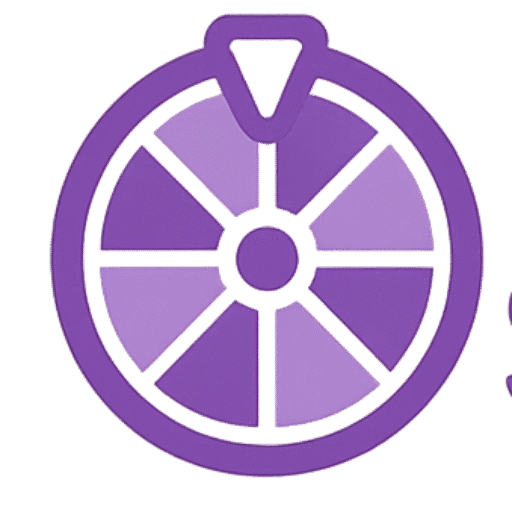




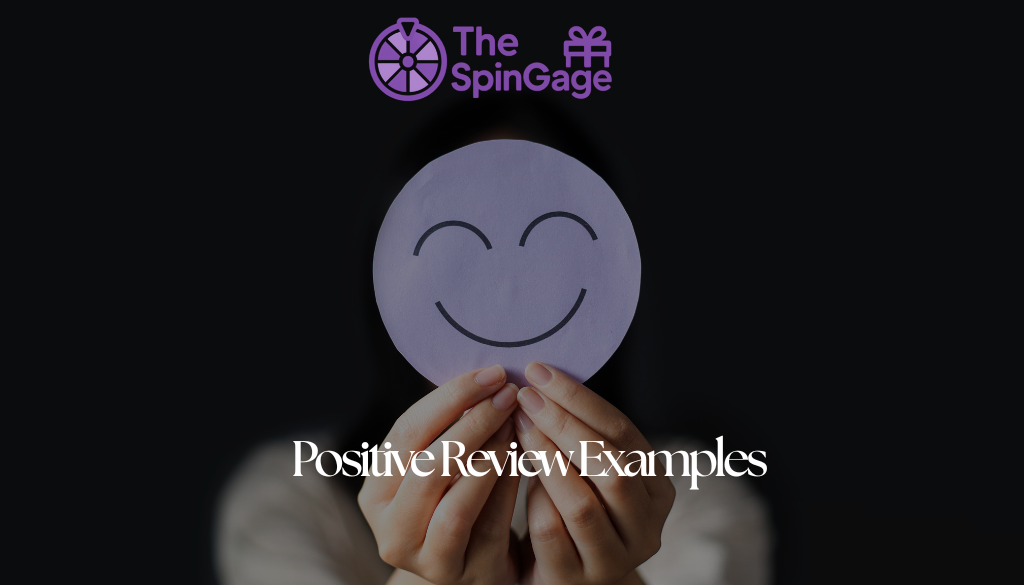
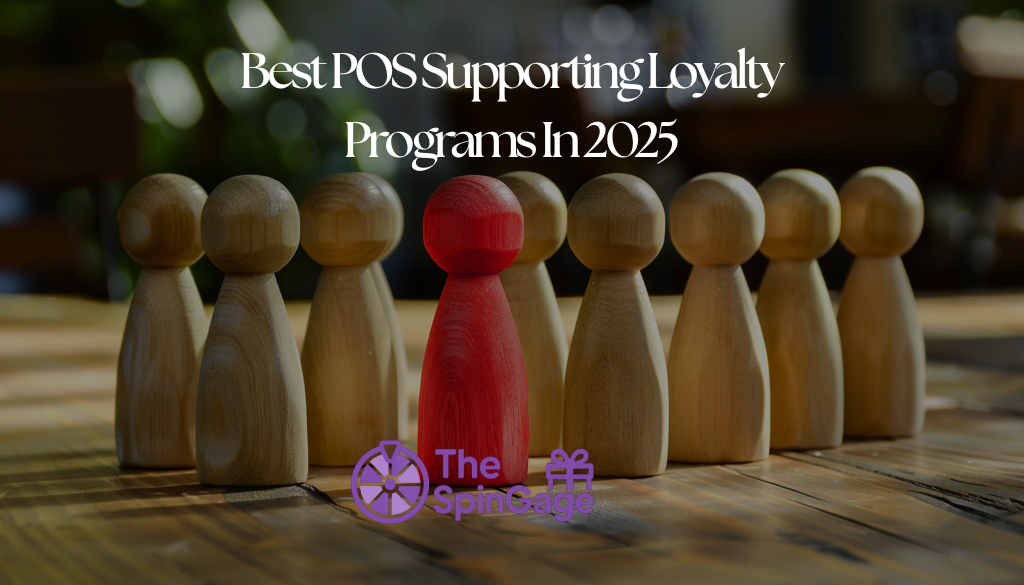
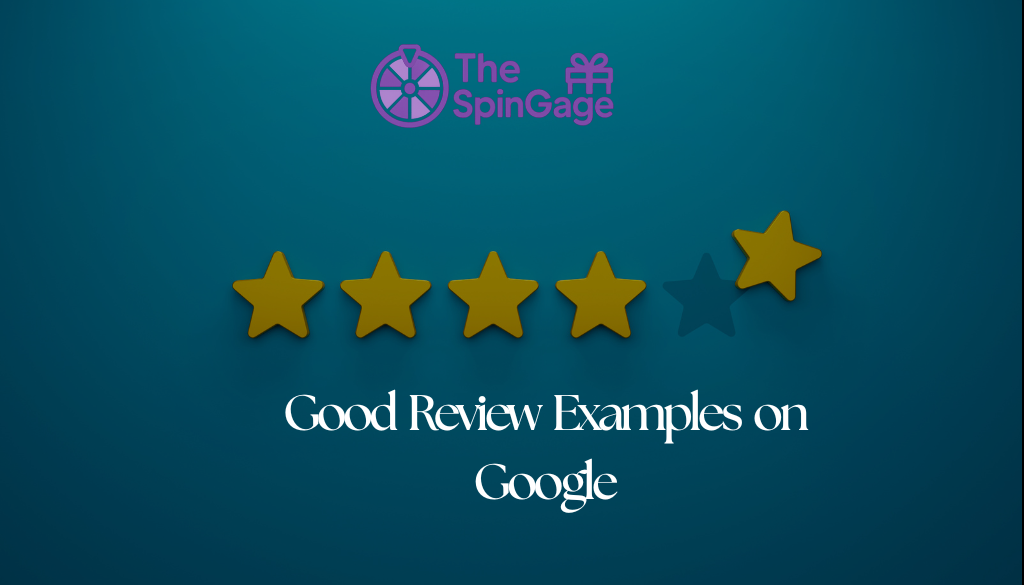



Leave a Reply